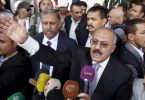I came to Yemen to better understand the deteriorating humanitarian crisis, including the fastest growing cholera epidemic the world has ever seen, the world’s largest food insecurity crisis and conditions of widespread population displacement.
This was my first mission to Yemen as Emergency Relief Coordinator.
It has been shocking to see the terrible impact of this man-made conflict.
In Sana’a and Aden, and during my visits to Lahj, Houdaydah, Hajjah, and Amran governorates, I have met hundreds of Yemenis, and listened to their stories of atrocious suffering.
Everywhere I have been, I have seen roads, bridges, factories, hotels, houses and much else which has been destroyed by the bombing and fighting. I have been to hospitals with barely any electricity or water, also a result of the fighting. I have met severely malnourished children, most likely being robbed of a healthy future. I have met some of the 2 million people who have been forced to move to avoid the conflict, and the dreadful conditions in which many of them now are forced to live. I have met health workers who have not been paid for months. I have heard from children who have not been to school for almost a year because their teachers’ salaries have not been paid.
Across the country, and on both sides of the frontline, Yemenis are being kept alive by brave humanitarian aid workers, working under extremely difficult conditions. Through contributions from our generous donors, we have scaled up the response and now provide direct assistance to more than 7 million people each month.
We are able to be effective because we remain impartial, neutral and independent, under the strong leadership of our Resident and Humanitarian Coordinator and his committed team. But we need to do more – and we need more support.
Both here in Sana’a and in Aden, I held frank discussions with authorities on the need for all parties and stakeholders to do more to ensure humanitarian assistance reaches all who need it.
In Aden I asked the Prime Minister, among other things, to ensure progress on paying salaries to health workers, teachers and other civil servants, to get Sana’a’s airport reopened for commercial and humanitarian flights and to improve the operation of the ports, especially Houdaydah.
He told me he would instruct his officials to pay health workers’ salaries. He also said he would be happy to see the four mobile cranes financed by the US government delivered to and installed in Houdaydah.
In Sana’a I have raised serious concerns about the operating environment facing UN and other humanitarian agencies. I am concerned about the increasing levels of interference in the work of the humanitarian agencies, including delays in granting and denial of visas, delays of essential equipment and supplies at the ports, bureaucratic impediments affecting NGOs and preventing essential assessments of needs so that we can target our assistance most effectively.
The authorities told me they would address these issues and in particular would release equipment belonging to the UN.
This visit has reaffirmed to me that the United Nations and partners have the capacity to further scale up. But we need more generous and timely donor financing, and demonstrated commitment by all parties to do all they can to help facilitate and never hinder humanitarians’ work.
An end to the horrendous suffering in Yemen requires above all a political resolution to the crisis.
In the meantime, I repeat the plea I made at the UN General Assembly in September. All parties in Yemen, and those outside who support and have influence over them, must do much more to ensure they respect international humanitarian law and protect civilians.
In the absence of substantial progress on all these points, the already dire situation will continue to deteriorate. The human suffering, already extreme, will grow and grow.
Original Article







